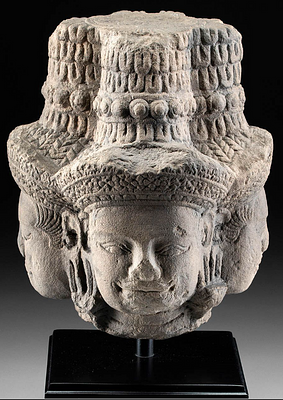Chinese Tang Dynasty Stone Seated Buddha
Lot 77
About Seller
Artemis Gallery
686 S Taylor Ave, Ste 106
Louisville, CO 80027
United States
Selling antiquities, ancient and ethnographic art online since 1993, Artemis Gallery specializes in Classical Antiquities (Egyptian, Greek, Roman, Near Eastern), Asian, Pre-Columbian, African / Tribal / Oceanographic art. Our extensive inventory includes pottery, stone, metal, wood, glass and textil...Read more
Categories
Estimate:
$20,000 - $30,000
Absentee vs Live bid
Two ways to bid:
- Leave a max absentee bid and the platform will bid on your behalf up to your maximum bid during the live auction.
- Bid live during the auction and your bids will be submitted real-time to the auctioneer.
Bid Increments
| Price | Bid Increment |
|---|---|
| $0 | $25 |
| $300 | $50 |
| $1,000 | $100 |
| $2,000 | $250 |
| $5,000 | $500 |
| $10,000 | $1,000 |
| $20,000 | $2,500 |
| $50,000 | $5,000 |
| $100,000 | $10,000 |
| $200,000 | $20,000 |
About Auction
By Artemis Gallery
Jun 29, 2023
Set Reminder
2023-06-29 10:00:00
2023-06-29 10:00:00
America/New_York
Bidsquare
Bidsquare : Exceptional Antiquities, Ethnographic and Fine Art
https://www.bidsquare.com/auctions/artemis-gallery/exceptional-antiquities-ethnographic-and-fine-art-13031
Artemis Gallery info@artemisgallery.com
Artemis Gallery info@artemisgallery.com
- Lot Description
East Asia, China, Tang Dynasty, ca. 618 to 907 CE. A magnificent and impressively sizeable, stone Buddha (Shakyamuni, the Enlightened form), traditionally robed and seated in full lotus position atop a double lotus throne pedestal with his right hand resting on his knee and his left extended outwards. His peaceful stance is consonant with his contemplative visage of downcast eyes, an elegant nose, pursed lips, and characteristically elongated ears - all topped by one of the most elegant topknots we have seen, finely delineated with a symmetrical arrangement of wavy tresses and curls. Draping his left shoulder, his robes cloak his slender figure, cascading down in billowing folds that fall to puddles of fabric in his lap. A sizable mandorla rises from his sloped shoulders, intricately carved with scrolling motifs and reliefs of the Five Wisdom Tathagatas. His throne is adorned with lotus flower petals and 8 faces, perhaps representing the Eight Consciousnesses. Size: 14.9" W x 34.8" H (37.8 cm x 88.4 cm)
Buddha's robes are skillfully rendered, draped in a naturalistic way, while his facial features are serene and lifelike. He presents an overall peaceful countenance with the body engaged in meditation and the visage presenting a rounded ushnisha symbolizing the wisdom and knowledge acquired after attaining enlightenment, as well as elongated ears, a physical feature symbolic of the Buddha's time as a prince when he wore elaborate ear ornaments to demonstrate wealth and prosperity. Of course, the prince stopped wearing them when he left the palace to become an ascetic; however, his earlobes remained stretched signifying a conscious decision to reject the material world in exchange for spiritual enlightenment and simultaneously suggest that the Buddha can hear all that is asked for and needed in the earthly world. Those half-closed eyes indicate a meditative state - at once looking both outward and inward. Furthermore, the curled hair of the Buddha signifies the nobility of Buddha. Beyond the multi-layered meaning embodied in the iconography of this piece, the sculptor's artistry and technique are exceptional.
PLEASE NOTE: Due to recent increases of shipments being seized by Australian & German customs (even for items with pre-UNESCO provenance), we will no longer ship most antiquities and ancient Chinese art to Australia & Germany. For categories of items that are acceptable to ship to Australia or Germany, please contact us directly or work with your local customs brokerage firm.
Please note that this item is heavy/oversized. Please inquire about shipping prior to bidding.
Provenance: private Vero Beach, Florida, USA collection, acquired before 2003
All items legal to buy/sell under U.S. Statute covering cultural patrimony Code 2600, CHAPTER 14, and are guaranteed to be as described or your money back.
A Certificate of Authenticity will accompany all winning bids.
We ship worldwide and handle all shipping in-house for your convenience.
#177243Missing left hand and right side of mandorla, as well as some minor losses to peripheries of base and expected nicks and abrasions to surface. Otherwise, excellent with nice preservation of detail.Condition
- Shipping Info
-
All shipping is handled in-house for your convenience. Your invoice from Artemis Gallery will include shipping calculation instructions. If in doubt, please inquire BEFORE bidding for estimated shipping costs for individual items.
-
- Buyer's Premium



 EUR
EUR CAD
CAD AUD
AUD GBP
GBP MXN
MXN HKD
HKD CNY
CNY MYR
MYR SEK
SEK SGD
SGD CHF
CHF THB
THB














